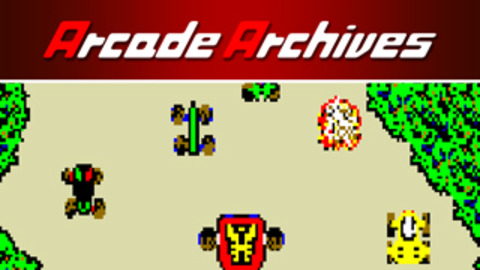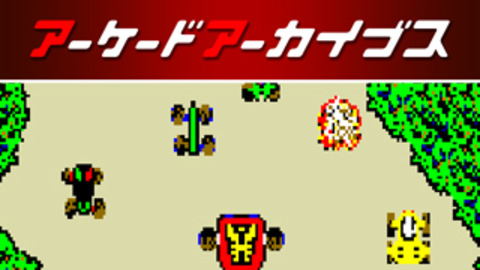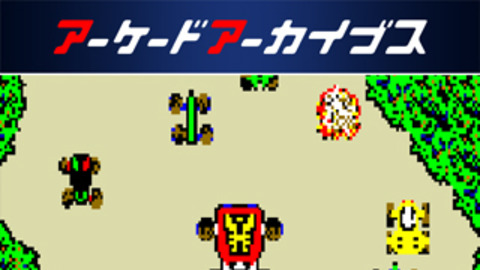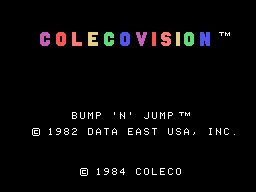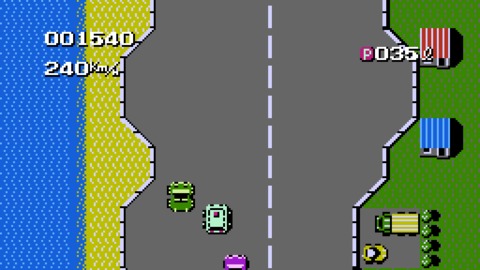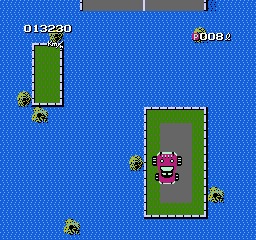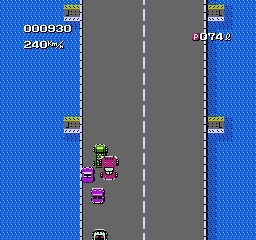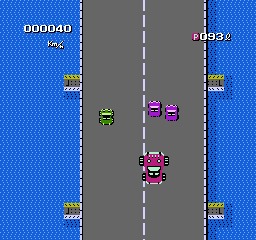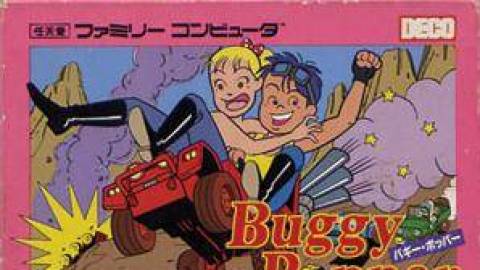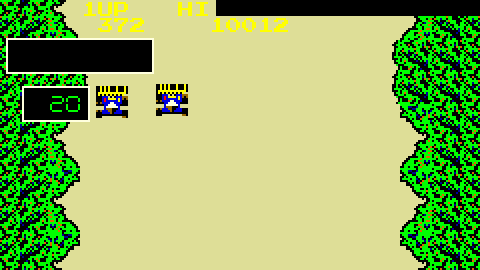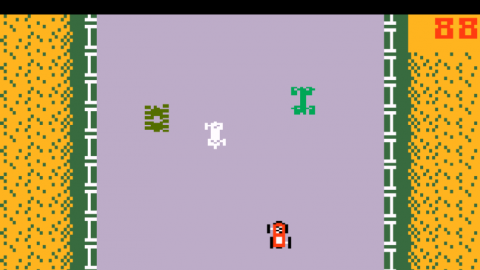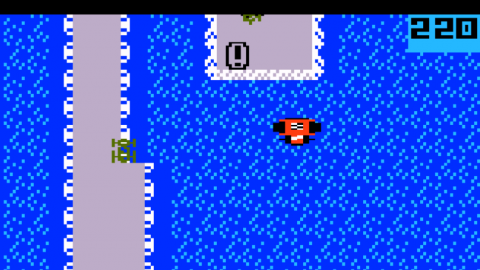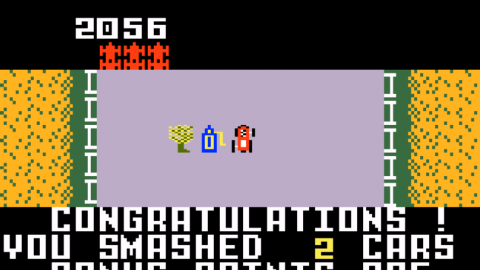Overview
Bump 'n' Jump (known outside of North America as Burnin' Rubber, which is not to be confused with the 1990 game of the same name) is a top-down action driving game developed and released by Data East in arcades (running either their DECO Cassette System hardware or dedicated hardware) in 1982. The North American dedicated hardware version was released by Bally-Midway.
It later received ports in 1983 and 1984, with North America receiving the Atari 2600 (ported by Mattel), Intellivision (ported by Mattel), and ColecoVision (ported by Coleco) ports and Europe receiving the Commodore 64 port (which was ported by Colosoftware). The game later received a port for the Nintendo Entertainment System by SAS Sakata (released in October 8, 1986 by Data East in Japan as Buggy Popper and later in December 1988 by Vic Tokai in North America), adding a new storyline (where the protagonist's girlfriend is kidnapped) and new gameplay mechanics (such as limited fuel).
Gameplay
In Bump 'N' Jump, players drive a red car down an open road at up to 220 MPH (or km/h in some versions). The main objective is to reach the gas station at the end of each roadway without crashing into obstacles, trees, or water. The road is filled with traffic of both light and heavy cars and trucks, some of which attempt to take the player's car out by bumping into it and sending it skidding to the side. Points are earned for progress made down the road, as well as bumping into other cars and sending them skidding off the road or into obstacles.
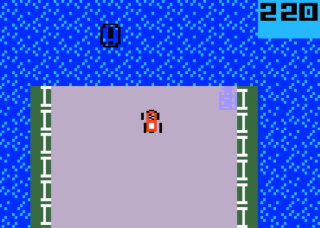
Once the player's car reaches 100 MPH, the car can jump high into the air. Around 40-50 MPH in speed will be lost by a single jump, so players will need to use some strategy to decide when it is most advantageous to utilize jumping. Jumping can come in handy to avoid skidding off the road when bumped, and also for avoiding patches of heavy traffic. Landing on enemy cars will destroy them and earn points.
Countless broken bridges, water, slight curves, and splits also pose problems along the road. Well-timed jumps are often the only way to clear some obstacles such as broken bridges, and also are the easiest way to clear most water hazards. Because timing is essential for clearing major hazards, a warning beep sounds and a "!" will appear at the top of the screen when a hazard requiring a jump is imminent (though some hazards may still have safe causeways on one side). Landing on islands in the middle of water or bridge hazards will earn bonus points.
At the end of a roadway, the number of enemy cars taken out is added to the player's score as bonus points, usually 300 to 500 points per car. In the event no enemies were crashed during the roadway, a significantly large bonus of 50,000 points will be awarded.
As with most retro games, the game ends once the player exhausts all their lives.
Levels
Roadways in Bump 'N' Jump are based off seasons. Once a player completes the first roadway, they start a Spring stage, then progress to a Summer stage, and so on, moving and repeating through all the seasons. The colors in these stages reflect their represented season, and offer little other change beyond increasing difficulty.
The variation of roadways varies between versions. In the arcade version, after the first three roads, the game begins a cycle of five roadways in order, repeating indefinitely until game over. The Intellivision version claims to have 32 unique roadways, while the Atari 2600 version has only eight (perhaps in the same manner as the arcade version).
Enemies
Differentiating every type of enemy car can be difficult, especially in console versions with lower detailed graphics. For the sake of simplicity, it is best to assume that any cars not mentioned here are light, may weave back and forth on the road in a non-hostile manner, and will skid a long way if hit.
The more important cars to watch for are listed below.
Tractor
The tractor is often mistaken as a tank by players, as it has large treads and a dark green appearance in some console versions. The tractor drives in a straight line, and is extremely slow and easy to pass. Bumping a heavy tractor will barely budge it, and will send the player skidding further than usual. For this reason, caution should be used when passing tractors on narrow sections of road.
Skull Car
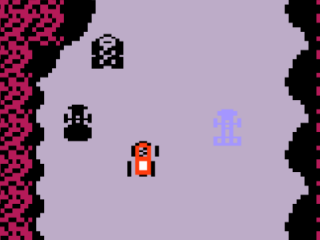
The skull car is obvious in appearance, as it has a large skull and crossbones on its roof. When the players gets near a skull car, it will usually move toward the player, attempting to bump them off the road and generally get in the way. While this is far more dangerous in writing than in practice, poorly-timed encounters with a skull car can cause bumping that slows a player down at a crucial moment, ruining a necessary jump. The same warning applies to narrow roads and splits, especially when trying to navigate around other vehicles.
Dump Truck
Arguably the most dangerous enemy in the game, the dump truck often moves faster than the player's top speed, and will dump out piles of debris that can crash the player if hit. Dump trucks only move in a straight line, and often must be watched closely while engaging other traffic. Simply touching a dump truck will destroy it -- an important fact to keep in mind if shooting for the 50,000 point no-kill bonus.
During the first roadway, and select seasons afterwards (depending on version), the dump truck will make its dumping animation, but won't actually dump any debris onto the road.
White Car
The white car is not as aggressive as the skull car, but will move towards the player and attempt to interfere upon approach. As with the skull car, care must be taken to avoid letting the white car botch jump speed and timing.
Yellow Truck
In more graphically detailed versions, this truck may be blue with a yellow front. Otherwise, it looks like a pure yellow heavy-duty dump truck. The yellow truck is appropriately heavy, much like the tractor, but also weaves across the road frequently, making it tougher to simply dodge.
Difficulty
While Bump 'N' Jump is not a difficult game to learn by any means, its difficulty varies from system to system. Successfully completing roadways often necessitates rote memorization, as the top-down view makes knowledge of upcoming splits and twists in hazards impossible. This is especially true in later stages, where the player may be required to time landings on small islands in the middle of hazards before jumping again, without knowing what speed is necessary to hit the island.
Some versions of the game are also stingy in handing out lives. The Intellivision version only explicitly promises one extra life at 20,000 points, and makes no mention of other opportunities for extra lives. In the arcade and Atari 2600 versions, where extra lives are awarded every 30,000 points, the best way to maintain a healthy supply of lives is by earning the 50,000 no-kill bonus as often as possible.
NES version
The NES version of Bump 'N' Jump came out in 1988, far later than earlier versions, and exhibits significant differences over its predecessors in both difficulty and storyline.
A plot is added in which the protagonist's girlfriend has been kidnapped by generic thugs, who he pursues over 16 stages. The seasons concept is thrown out for a more diversely themed set of stages, featuring cityscapes, beaches, and cliffsides. Some stages also contain bonus air targets, which can be hit at the peak of a jump.
The difficulty for this version is also much higher, with only three lives available to start and very high score thresholds to attain extra lives. In addition, P-fuel cells need to be gathered along the road, in order to keep a rapidly-depleting fuel tank full. Running out of fuel costs a life, which makes the process of surviving all the more bothersome. A few recharge stations can be entered in certain stages throughout the game, which starts a lengthy button mashing bonus sequence to regain P-fuel.
Upon reaching the end of stage 16, the player engages in a boss fight with the enemy car carrying his girlfriend. Running out of P-fuel here does not kill the player, but renders them unable to jump regardless of speed. After the boss is jumped on enough times and destroyed, a cutscene plays, and the 16 stages begin all over again.

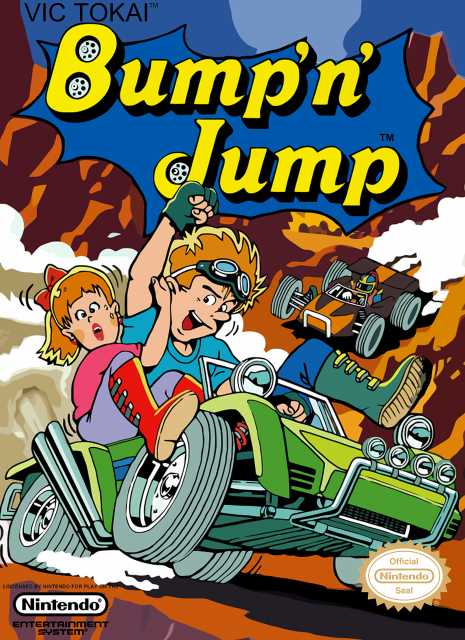
 Amstrad CPC
Amstrad CPC PlayStation 4
PlayStation 4 Nintendo Switch
Nintendo Switch